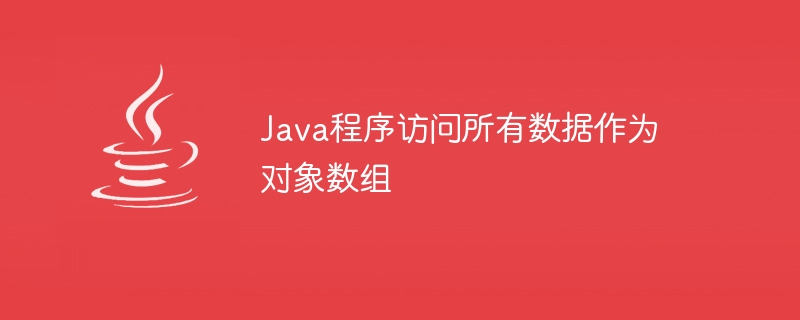Java程式存取所有資料作為物件數組
- PHPz轉載
- 2023-08-26 16:17:061003瀏覽

陣列是一種線性資料結構,用於儲存具有相似資料類型的元素組。我們可以使用原始資料類型來建立數組,並且由於類別被視為使用者定義的資料類型,因此也可以建立物件數組。
在本文中,我們將討論物件數組,並建立 java 程式來以物件數組的形式存取所有資料。
物件陣列或物件陣列
物件數組實際上包含物件的引用變量,即物件數組中儲存的元素是引用類型。我們遵循相同的語法來創建基元數組和物件數組。然而,在物件數組的情況下,我們使用類別名稱而不是原始資料類型。
基元數組的語法
Data_Type[] nameOfarray;
// declaration
Or,
Data_Type nameOfarray[];
// declaration
Or,
// declaration with size
Data_Type nameOfarray[] = new Data_Type[sizeofarray];
// declaration and initialization
Data_Type nameOfarray[] = {values separated with comma};
實例
String[] item = new String[5];
在上面的範例中,我們建立了一個可以儲存 5 個字串元素的字串陣列。
物件數組的語法
Class_name objectArray[]; // declaration Or, // declaration and instantiation Class_name objectArray[] = new Class_name[sizeofarray];
實例
Cart[ ] obj = new Cart[5];
在上面的範例中,我們建立了一個物件數組,可以儲存 5 個 Cart 類別的物件。我們使用類別名稱而不是原始資料類型。
請記住,當我們宣告並初始化物件陣列時,它不會自動為元素建立對象,而是我們需要為每個元素單獨建立物件。
實例化物件陣列後,我們需要用值初始化陣列的元素。在這種情況下,物件就是元素。傳遞值的一種方法是使用類別的建構函數,或者我們可以建立多個對象,然後將它們傳遞給另一個物件陣列。
文法
arrayObject_name[index] = new constructor_name( values ); Or, arrayObject_name[index] = object_name;
我們將在下一節中看到範例。
Java 程式以物件陣列的形式存取所有資料
範例 1
在下面的範例中,我們將建立一個物件數組,並使用建構函式使用值對其進行初始化。
class Cart {
String item;
double price;
Cart(String item, int price) {
// Constructor
this.item = item;
this.price = price;
}
}
public class Main {
public static void main(String[] args) {
Cart[ ] obj = new Cart[5];
// creation of object array
// Passing values to the array object
obj[0] = new Cart("Rice", 59);
obj[1] = new Cart("Milk", 60);
obj[2] = new Cart("Bread", 45);
obj[3] = new Cart("Peanut", 230);
obj[4] = new Cart("Butter", 55);
System.out.println("Accessing data as Object Array: ");
int i = 0;
// initialization of loop variable
while(i < obj.length) {
// to iterate through array obejct
System.out.println("Item: " +obj[i].item + ", " + "Price: " +obj[i].price);
// to print the values
i++;
// incrementing loop variable
}
}
}
輸出
Accessing data as Object Array: Item: Rice, Price: 59.0 Item: Milk, Price: 60.0 Item: Bread, Price: 45.0 Item: Peanut, Price: 230.0 Item: Butter, Price: 55.0
在上面的範例中,我們建立了類別“Cart”及其建構函式“Cart”,該建構函式接受兩個參數“item”和“price”。在 main 方法中,我們建立了類別「Cart」的大小為 5 的物件「obj」陣列。透過使用構造函數“Cart”,數組的元素被初始化。我們使用 while 迴圈來列印值。
範例 2
以下範例說明了以物件陣列形式存取資料的另一種方法。
class Cart {
String item;
double price;
}
public class Arrayobj {
public static void main(String []args) {
// Initializing the values to the variables
Cart c1 = new Cart();
// object 1
c1.item = "Rice";
c1.price = 59;
Cart c2 = new Cart();
// object 2
c2.item = "Milk";
c2.price = 60;
Cart c3 = new Cart();
// object 3
c3.item = "Bread";
c3.price = 45;
Cart obj[] = new Cart[3];
// array of object
// Passing objects to object array
obj[0] = c1;
obj[1] = c2;
obj[2] = c3;
for(int i = 0; i < obj.length ; i++ ) {
System.out.println("Item: " +obj[i].item + ", " + "Price: " +obj[i].price);
}
}
}
輸出
Item: Rice, Price: 59.0 Item: Milk, Price: 60.0 Item: Bread, Price: 45.0
在上面的範例中,我們建立了類別「Cart」及其三個物件「c1」、「c2」、「c3」。此外,我們也建立了類別「Cart」的大小為 3 的物件「obj」陣列。透過使用對象,數組的元素被初始化。我們使用 for 迴圈來列印值。
結論
在本文中,我們了解了基元數組和物件數組之間的異同。在兩個java程式的幫助下,我們討論如何以物件數組的形式存取資料。
以上是Java程式存取所有資料作為物件數組的詳細內容。更多資訊請關注PHP中文網其他相關文章!

